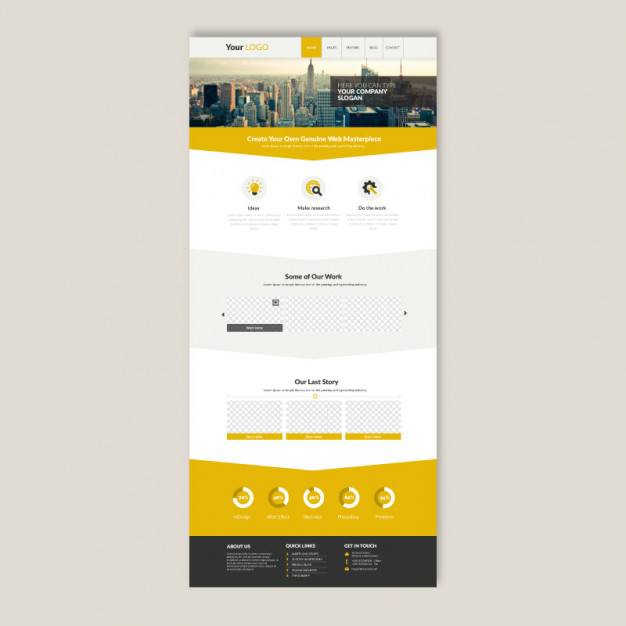Yet, while web development can consolidate a highway towards e-commerce success, the rate of success is gradually being defined by some fundamental principles. Almost anyone from any jurisdiction can place any sell-able item and service on the internet. Furthermore, the ease that the template-based websites have been emerging makes modern e-commerce extremely competitive. Consequently, having a profitable e-commerce website today, and one that is competitively unique, needs a refined approach that is both strategic and purpose-based.[1] This article highlights five fundamental requirements for modern business-centered web development. The five fundamental guidelines reviewed here have been tested and validated as part of a reliable blueprint, not only to make your e-commerce website distinctive and competitive, but also to help you exploit the potential of modern web development towards absolute e-commerce profitability.
Fundamental Blueprints for E-commerce Web Development
1. Advanced Applications
The first mandatory element of modern web development for business-centered portals, which defines the success and profitability of that business, is the incorporation of practical applications. Taking advantage of recent technological developments, modern web development now integrates the use of specialized tools that trigger exceptional business operations.
Image Source Perhaps the most significant of these tools is the incorporation of mobile-friendly applications in e-commerce. It is now possible to access an e-commerce site from assorted mobile devices, including mobile phones, tablets, smart phones, laptops, and desktop computers. The content is designed to automatically resize and fit any of these access devices perfectly, without compromising the quality of such content. Accessibility on any device can potentially increase e-commerce site traffic, which in turn can increase the number of visitors converted to actual customers, and ultimately positively influences the sales column of a business. Several reliable service providers can now develop single or multiple applications for an e-commerce site, customize and deploy such applications on the site, and even offer reliable maintenance for the suite of applications used on a site for the long term. For example, using a Ruby on Rails developer helps develop, customize, deploy, and maintain the most advanced applications for modern e-commerce. Ultimately, being able to incorporate progressively advanced applications on a website helps modern web development reach and sustain unprecedented levels of success in e-commerce.
2. Customizable Applications
In addition to having numerous standard applications on a website, modern web development also facilitates custom site application development that is reflective and adaptive to the site’s requirements. Entrepreneurial success relies heavily on being unique, whether online or offline. Therefore, after installing standard applications, web development helps you redesign, enhance, update, upgrade, and customize applications to exclusively serve the purpose of e-commerce. Some sites have creatively employed cutting edge web development to facilitate marketing, presentation, and sale of goods and services simultaneously, where a single customized application can do any of these for prospective customers. Whether using a reliable e-commerce website builder or otherwise, the potential to customize applications with modern web development is particularly useful when branding a business, keeping the focus either on specific products/services being offered or the company.[2] This helps to give online shoppers an identity of products/services to remain loyal to and to competitively differentiate among available alternatives. With modern web development, an e-commerce site easily graduates to a brand or a purchase point for a specific brand. This, therefore, makes it necessary to introduce a customized search application. The search mechanism customized for the specific site not only aids navigation when surfing an e-commerce website (a review of which follows), but also enables users to conveniently pursue their desired brand.
Image Source
3. User-Friendly and Convenient Customer Service
How easily and effectively can a visitor find the product/service they need on an e-commerce portal? Well, no user visits an e-commerce site for the lack of anything else to do or because they have time to waste. Most visitors are attracted by a business offer and their experience while on the site determines whether they are converted from visitors to customers or remain mere visitors. If the use of an e-commerce site is confusing or time-consuming, there are numerous alternatives available elsewhere. Consequently, even before considering the quality and the selling ability of web content, the first requirement is to attain optimal ease of navigation for the user. Modern web development helps an e-commerce site attain user-friendly interface, which allows visitors to find what they need conveniently and effectively. Just like the quality of customer service determines the success of an offline store, customer service on an e-commerce site is determined by how convenient, effective, and user-friendly the site’s navigation is for visitors. Furthermore, the convenience, effectiveness, and user-friendly navigation of a profitable e-commerce site is also determined by such elements of modern web development, like:
The number and convenience of payment options available (old and new) when checking out at the site (the more options the better), and fluidity of international currencies[3] (i.e. PayPal, cheques, debit cards, credit cards, Western Money Transfer, Payoneer, etc.) Reliable, affordable, and convenient communication channels (i.e. email, chat, fax, telephone, etc.) Ability of web development applications to facilitate marketing, presentation, and sale of products/services simultaneously, based on individual customer interests Effectiveness of a search function to help visitors access exactly what they want easily and rapidly Site design features customized seamlessly to match the products and services on offer, where applications adopt a size, style, layout, and functionality unique to the e-commerce product/service being offered Presence of unique call-to-action buttons, prompting the customer to make a purchase, order, or save in a shopping cart[4]
Image Source Categorization of products/services in logical groupings and sub-groupings so that desired products/services are easy to locate and the site makes it simple and convenient for the visitor to convert to a customer.
4. Attaining a High-Quality Visual Appeal
The visual appeal of an e-commerce site attracts and retains the interest of a potential customer long before textual content.[5] Pieter’s and Weddle conducted a research study to relate 1,363 distinctive print advertisements and the cycle of an infrared eye-tracking device used on over 3,600 consumers. Ultimately, the study established that the visual appeal of an advert (integration of brand, image, and text) has the highest success rate of capturing attention and that this technique can effectively be put to use in advertising.[6]
Image Source Even offline stores and supermarkets exploit the potential of displays to make customers forget their budget and instead purchase what appeals to their eyes. Modern web development helps to captivate visitors with photos and textual marketing messages with an attractive set of graphical images. With precise skill, a site can effectively integrate an attractive and high-quality set of product photographs, portraying exactly what appeals to a customer, which provokes buying decision. Modern web development helps graphically display logical, organized, orderly, and an intuitive categorization of products/services on an e-commerce site, making it easy for a visitor to use the site and navigate through the product list. An e-commerce site’s clear, highly defined, and optimized visual quality also helps ensure that the site’s design does not overpower the products and diminish their appeal. Strategic web development employs minimalist site design features (simple and easy to navigate), in a move to draw a visitor’s attention to the product/service on offer. Strategic web development does not allow a site to compete for a visitor’s attention, but to focus that attention to the e-commerce goal.
5. Enabling Long-Term Customer Relations
Finally, it is also important that web development helps create an instinctive, simple to use connection and relationship with the customer. Getting a prospective customer to an e-commerce site and achieving a conversion from a visitor to a customer is not enough to sustain optimal profitability of a business. The long-term goal is to make the customer register on the site and keep them coming back. As such, instead of requiring a customer to always register a new, modern web development can help consolidate, save, and progressively use the same customers’ identity (username, email address, and password). This makes the customers’ checkout process easy and straightforward, and increases their chance of return.
Image Source With such applications, a customer can easily sign in to an e-commerce site, check on the progress of previous orders, return an earlier order, and even communicate with the customer support team. Such a registry helps qualify the identity and demographic profile (age, gender, residential area, preferences, etc.) of customers, which helps refine the marketing and sales operations of the business. Finally, modern web development helps build and sustain a relationship with the customer by providing numerous communication channels, such as messengers, chat, email, and telephone. Indeed, part of the details customers provide during sign-up includes their name, physical address, preferred payment options, and contact details. Modern web development has also facilitated the integration of social media platforms, and further linking a customer with a brand or a business site. The social media applications including Twitter, Facebook, Instagram, YouTube, LinkedIn, Google+, Tumblr, and many others help to sustain a long-term relationship for the benefit of an e-commerce venture.
Image Source Several other features of contemporary web development are also significant in determining the success of modern e-commerce, such as ensuring adequate and sustainable returns on investment (getting the best out of a website with minimal expenditure) and simultaneously enabling the marketing, presentation, and sale of products/services with an integrated application. However, the five features of modern web development have been tried, tested, and validated by assorted e-commerce initiatives as the foundation of their success. The five features of modern web development, which include (a) advanced applications, (b) customizable applications, (c) user-friendly and convenient customer service, (d) attaining a high-quality visual appeal, and (e) enabling long-term customer relations, are indeed all a part of the critical blueprint that can make your e-commerce website not only distinctive and competitive, but also anchored on sustainable profitability. Featured photo credit: https://stocksnap.io/ via stocksnap.io





